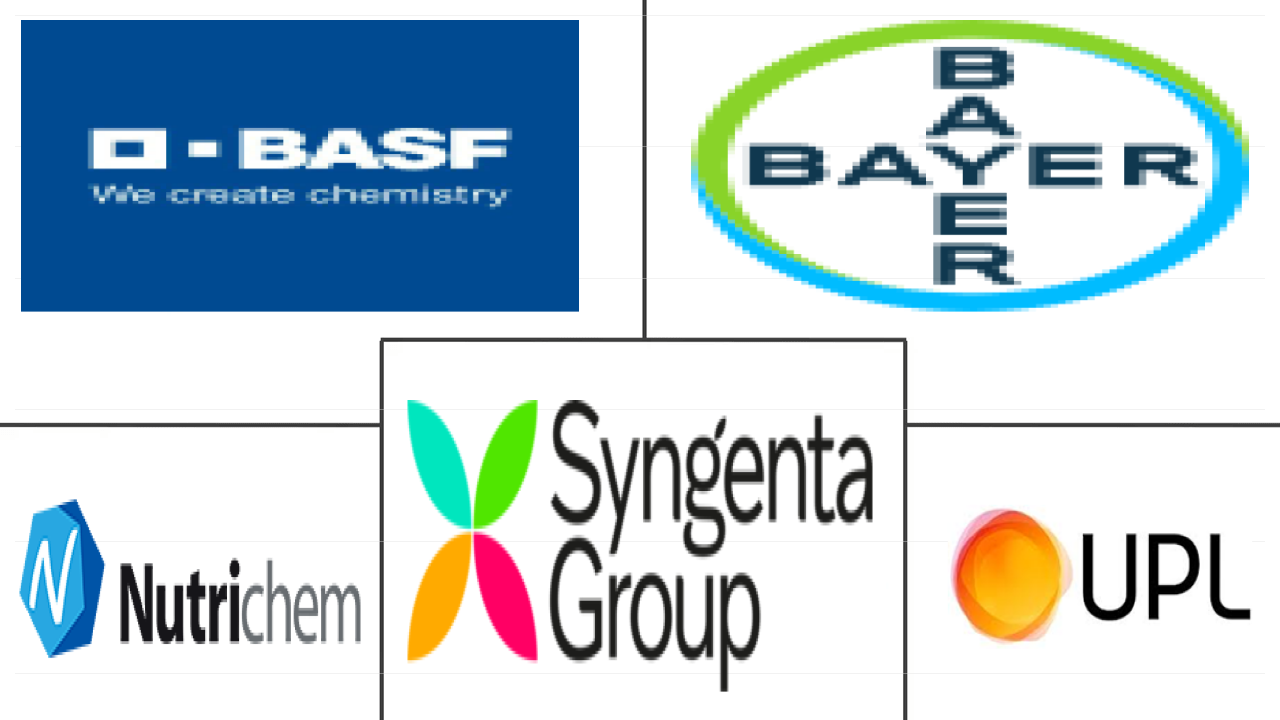Market Size of china fungicide Industry
| Icons | Lable | Value |
|---|---|---|
|
|
Study Period | 2017 - 2029 |
|
|
Market Size (2024) | USD 1.29 Billion |
|
|
Market Size (2029) | USD 1.59 Billion |
|
|
Largest Share by Application Mode | Foliar |
|
|
CAGR (2024 - 2029) | 4.16 % |
|
|
Fastest Growing by Application Mode | Foliar |
|
|
Market Concentration | Medium |
Major Players |
||

|
||
|
*Disclaimer: Major Players sorted in no particular order |
China Fungicide Market Analysis
The China Fungicide Market size is estimated at 1.29 billion USD in 2024, and is expected to reach 1.59 billion USD by 2029, growing at a CAGR of 4.16% during the forecast period (2024-2029).
1.29 Billion
Market Size in 2024 (USD)
1.59 Billion
Market Size in 2029 (USD)
1.92 %
CAGR (2017-2023)
4.16 %
CAGR (2024-2029)
Largest Segment by Application Mode
60.20 %
value share, Foliar, 2023
Effectiveness in controlling fungal diseases by directly targeting them with rapid action and advancements in foliar equipment enhance the foliar fungicide application.
Largest Segment by Crop Type
51.97 %
value share, Grains & Cereals, 2023
Grains and cereals occupy higher cultivation areas and are prone to more yield losses by diseases like stripe rust, powdery mildew, rice blast, and increasing fungicide usage.
Fastest-Growing Segment by Crop Type
4.37 %
Projected CAGR, Fruits & Vegetables, 2024-2029
Growing cultivation areas, rising demand for fresh produce, and increased fungal disease pressure in the fruits and vegetables sector have increased the fungicide adoption rate.
Leading Market Player 1
27 %
market share, Nutrichem Co. Ltd, 2022

Nutrichem's advanced research and development centers and strong product supply capabilities offering various fungicide products have boosted the growth of the fungicides market.
Leading Market Player 2
14.86 %
market share, Syngenta Group, 2022

Gold Ray, Ruizhen, AmiColor, and Amicida are a few of the fungicidal products offered by the company for crops, including soybean, wheat, rice, peanuts, tomato, etc.
Foliar application dominated the Chinese fungicide market owing to its quick action
- China has a well-established fungicide manufacturing industry, with several domestic companies producing fungicide formulations and active ingredients. Major fungicide classes used in China include triazoles, strobilurins, benzimidazoles, dithiocarbamates, and quinone outside inhibitors (QoIs). These fungicides have different modes of action and target specific fungal pathogens. China accounted for 38.7% of the Asia-Pacific fungicide market in 2022.
- Foliar application dominated the Chinese fungicide market and accounted for a share of 60.2% in 2022. Fungicides applied in foliar can provide rapid action against fungal pathogens. They are typically formulated to have quick absorption and translocation properties within the plant. This allows the fungicide to reach the affected tissues and inhibit or kill the fungi, reducing disease progression and preventing further damage.
- Seed treatment accounted for 14.0% of the Chinese fungicide market in 2022. Fungal infections can weaken and stunt the development of plants. Fungicide seed treatments can help plants maintain their health and vigor by preventing or lowering disease damage. This allows the plants to allocate more energy toward growth and development, leading to healthier and more productive crops. The market value of seed treatment between 2017 and 2022 increased by USD 12.6 million.
- Exports of fungicides from China are also projected to increase by 2026. In 2021, the country exported 110.2 million kg of fungicides. By 2026, exports are projected to reach 125.6 million kg. This factor may further drive the fungicide market, which is anticipated to register a CAGR of 3.7% during the forecast period.
China Fungicide Industry Segmentation
Chemigation, Foliar, Fumigation, Seed Treatment, Soil Treatment are covered as segments by Application Mode. Commercial Crops, Fruits & Vegetables, Grains & Cereals, Pulses & Oilseeds, Turf & Ornamental are covered as segments by Crop Type.
- China has a well-established fungicide manufacturing industry, with several domestic companies producing fungicide formulations and active ingredients. Major fungicide classes used in China include triazoles, strobilurins, benzimidazoles, dithiocarbamates, and quinone outside inhibitors (QoIs). These fungicides have different modes of action and target specific fungal pathogens. China accounted for 38.7% of the Asia-Pacific fungicide market in 2022.
- Foliar application dominated the Chinese fungicide market and accounted for a share of 60.2% in 2022. Fungicides applied in foliar can provide rapid action against fungal pathogens. They are typically formulated to have quick absorption and translocation properties within the plant. This allows the fungicide to reach the affected tissues and inhibit or kill the fungi, reducing disease progression and preventing further damage.
- Seed treatment accounted for 14.0% of the Chinese fungicide market in 2022. Fungal infections can weaken and stunt the development of plants. Fungicide seed treatments can help plants maintain their health and vigor by preventing or lowering disease damage. This allows the plants to allocate more energy toward growth and development, leading to healthier and more productive crops. The market value of seed treatment between 2017 and 2022 increased by USD 12.6 million.
- Exports of fungicides from China are also projected to increase by 2026. In 2021, the country exported 110.2 million kg of fungicides. By 2026, exports are projected to reach 125.6 million kg. This factor may further drive the fungicide market, which is anticipated to register a CAGR of 3.7% during the forecast period.
| Application Mode | |
| Chemigation | |
| Foliar | |
| Fumigation | |
| Seed Treatment | |
| Soil Treatment |
| Crop Type | |
| Commercial Crops | |
| Fruits & Vegetables | |
| Grains & Cereals | |
| Pulses & Oilseeds | |
| Turf & Ornamental |
China Fungicide Market Size Summary
The China fungicide market is characterized by a robust manufacturing sector, with numerous domestic companies producing a variety of fungicide formulations and active ingredients. The market is dominated by several key classes of fungicides, including triazoles, strobilurins, benzimidazoles, dithiocarbamates, and quinone outside inhibitors, each targeting specific fungal pathogens through different modes of action. Foliar application is the predominant method of use, offering rapid action against fungal infections, while seed treatment also plays a significant role in maintaining plant health and vigor. The market is influenced by regulatory measures aimed at controlling fungicide usage, promoting integrated pest management strategies, and encouraging the development of disease-resistant crop varieties. These efforts have led to a decrease in fungicide consumption per hectare, as well as a shift towards biological control agents and sustainable agricultural practices.
The market is moderately consolidated, with major players such as BASF SE, Bayer AG, Nutrichem Co. Ltd, Syngenta Group, and UPL Limited holding significant shares. The pricing of active ingredients is affected by various factors, including weather conditions, disease outbreaks, energy prices, and labor costs. China is also a significant exporter of fungicides, with exports projected to increase in the coming years. The market's growth is supported by ongoing innovations and partnerships aimed at enhancing crop protection technologies and developing eco-friendly solutions. These developments are expected to contribute to the market's expansion, with a steady growth trajectory anticipated over the forecast period.
China Fungicide Market Size - Table of Contents
-
1. MARKET SEGMENTATION (includes market size in Value in USD and Volume, Forecasts up to 2029 and analysis of growth prospects)
-
1.1 Application Mode
-
1.1.1 Chemigation
-
1.1.2 Foliar
-
1.1.3 Fumigation
-
1.1.4 Seed Treatment
-
1.1.5 Soil Treatment
-
-
1.2 Crop Type
-
1.2.1 Commercial Crops
-
1.2.2 Fruits & Vegetables
-
1.2.3 Grains & Cereals
-
1.2.4 Pulses & Oilseeds
-
1.2.5 Turf & Ornamental
-
-
China Fungicide Market Size FAQs
How big is the China Fungicide Market?
The China Fungicide Market size is expected to reach USD 1.29 billion in 2024 and grow at a CAGR of 4.16% to reach USD 1.59 billion by 2029.
What is the current China Fungicide Market size?
In 2024, the China Fungicide Market size is expected to reach USD 1.29 billion.

